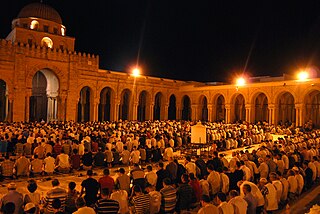
Ḥadīth or Athar in Islam refers to what the majority of Muslims believe to be a record of the words, actions, and the silent approval of the Islamic prophet Muhammad as transmitted through chains of narrators. In other words, the ḥadīth are transmitted reports about what Muhammad said and did.

Muhammad ibn Isma'il al-Bukhari, commonly referred to as Imām al-Bukhāri or Imām Bukhāri, was a 9th-century Persian Muslim muhaddith. Widely regarded as one of the most important hadith scholars in the history of Islam, Al-Bukhari's extant works include the hadith collection Sahih al-Bukhari, Al-Tarikh al-Kabir, and Al-Adab al-Mufrad.

Sahih al-Bukhari is a hadith collection and a book of sunnah compiled by the Persian scholar Muḥammad ibn Ismā‘īl al-Bukhārī (810–870) around 846. Alongside Sahih Muslim, it is one of the most valued books in Sunni Islam after the Quran. Both books are part of the Kutub al-Sittah, the six major Sunni collections of hadith of the Islamic prophet Muhammad. The book is also revered by Zaydi Shias. It consists of an estimated 7,563 hadith narrations across its 97 chapters.

Sahih Muslim is a 9th-century hadith collection and a book of sunnah compiled by the Persian scholar Muslim ibn al-Ḥajjāj (815–875). It is one of the most valued books in Sunni Islam after the Quran, alongside Sahih al-Bukhari. Sahih Muslim is also one of the Kutub al-Sittah, the six major Sunni collections of hadith of the Islamic prophet Muhammad. The book is also revered by Zaydi Shias. It consists of approximately 7,500 hadith narrations across its introduction and 56 books.

Tarawih, also rendered in English as Taraweeh, is derived from the Arabic root ر و ح related to rest and relaxation. Tarawih prayers are special Muslim prayers involving reading long portions of the Quran, as well as performing many rakahs. They are exclusive to the Sunni denomination of Islam

Sunan Abu Dawood is one of the Kutub al-Sittah, collected by Abu Dawud al-Sijistani (d.889).

Al-Sunan al-Sughra, also known as Sunan al-Nasa'i, is one of the Kutub al-Sittah, and was collected by al-Nasa'i.

The Hadith of the Twelve Successors is a widely-reported prophecy, attributed to the Islamic prophet Muhammad, predicting that there would be twelve successors after him. As there were many more rulers after Muhammad, Sunni authors have variously identified these twelve successors with some of these rulers. In Twelver Shia, these successors are instead the Twelve Imams. The last one, Muhammad al-Mahdi, is believed to be in occultation since 874 CE. While the details vary, the belief in the eschatological Mahdi remains popular among all Muslims, possibly owing to numerous traditions to this effect in canonical Sunni and Shia sources.

The Kutub al-Sittah are six books containing collections of hadith compiled by six Sunni Muslim scholars of Persian origin in the ninth century CE, approximately two centuries after the death of Muhammad. They are sometimes referred to as al-Sihah al-Sittah, which translates as "The Authentic Six". They were first formally grouped and defined by Ibn al-Qaisarani in the 11th century, who added Sunan ibn Majah to the list. Since then, they have enjoyed near-universal acceptance as part of the official canon of Sunni Islam.

The Four Books, or The Four Principles, is a Twelver Shia term referring to their four best-known hadith collections:

Reality of Certainty is a Shiite collection of hadiths authored by Muhammad Baqir Majlisi in the 16th century.

Muḥammad Zakarīyā ibn Muḥammad Yaḥyá Ṣiddīqī Kāndhlawī Sahāranpūrī Muhājir Madanī was a Sunni Hanafi Hadith scholar of the Deobandi school of Islamic thought in India, popularly known as a "Hazrat Shaykh al-Hadith" and an influential ideologue of Tablighi Jamaat, the missionary and reform movement founded by his uncle Maulana Muhammad Ilyas. His notable works are Awjaz al-Masalik, an Arabic commentary in six volumes on Imam Malik's Muwatta, and Khasa'il-i Nabawi, an Urdu translation and commentary on Imam at-Tirmidhi's Shama'il.
A famous recorded oral tradition among Muslims is about comment made by Imran ibn Husain, one of the companions of Muhammad and a Narrator of hadith. The comment was regarding the prohibition of Mut'ah, a word with several meanings. It is used in both Nikah mut'ah and Mut'ah of Hajj.

Al-Kafi is a Twelver Shia hadith collection compiled by Muhammad ibn Ya'qub al-Kulayni. It is divided into three sections: Uṣūl al-Kāfī, dealing with epistemology, theology, history, ethics, supplication, and the Qurʾān, Furūʿ al-Kāfī, which is concerned with practical and legal issues, and Rawdatal-Kāfī, which includes miscellaneous traditions, many of which are lengthy letters and speeches transmitted from the Imāms. In total, al-Kāfī comprises 16,199 narrations.

Abu Hasan Ali ibn Umar ibn Ahmad ibn Mahdi al-Daraqutni was a 10th-century muhaddith best known for compiling the hadith collection Sunan al-Daraqutni. He was celebrated later by Sunni hadith scholars such as the "imam of his time" and the "amir al-mu'minin in hadith".

Hadith of Fatima tablet, also known as the Hadith of Lowh of Fatima is a tradition of Imam al-Sadiq who narrated his father Imam al-Baqir who in turn quoted Jabir ibn Abdullah as the original narrator of the hadith. This hadith specifically names twelve Imams as successors to Muhammad, prophet of Islam.

As-Sunan al-Kubra,, is a hadith book collected by Imam Al-Nasa'i, not to be confused with the same titled book by Imam Al-Bayhaqi.
Canonized Islamic scripture are texts which Muslims believe were revealed by God through various prophets throughout humanity's history—specifically the Quran and Hadith. Muslims believe the Quran to be the final revelation of God to mankind, and a completion and confirmation of previous scriptures. It was believed to have been revealed to the Islamic prophet Muhammad from 620 CE to 632 CE, and canonized in an official, unified text during the caliphate of Rashidun Uthman, around 650 CE.










